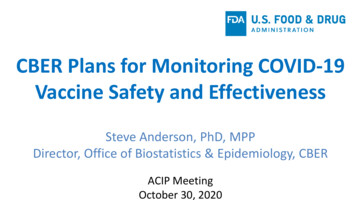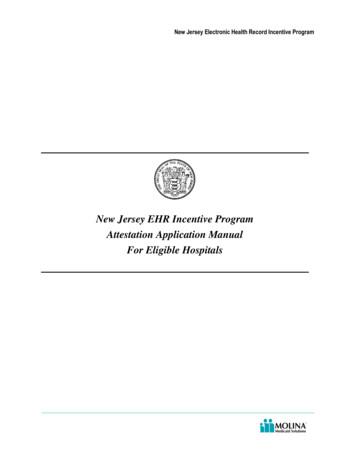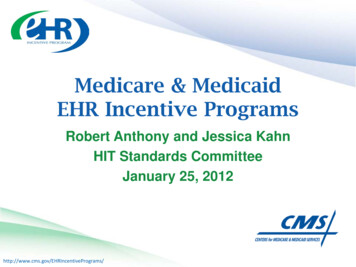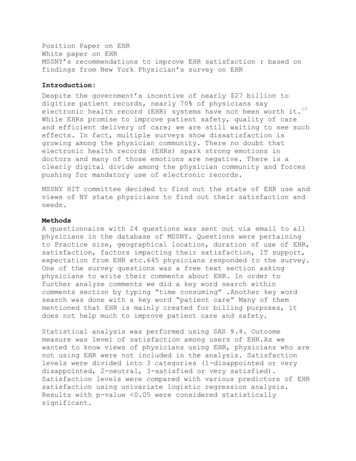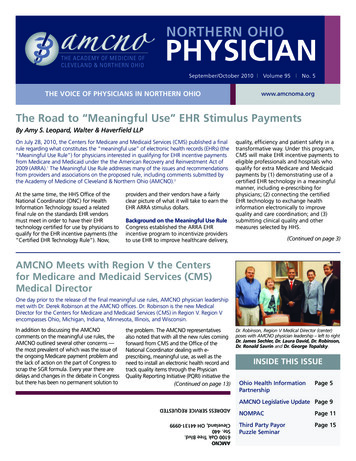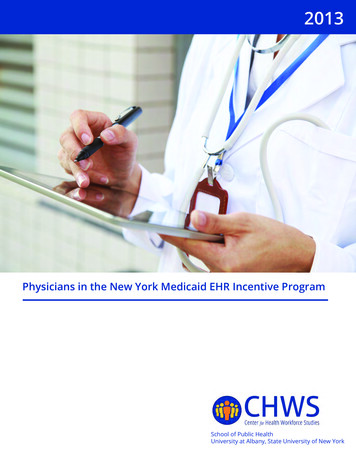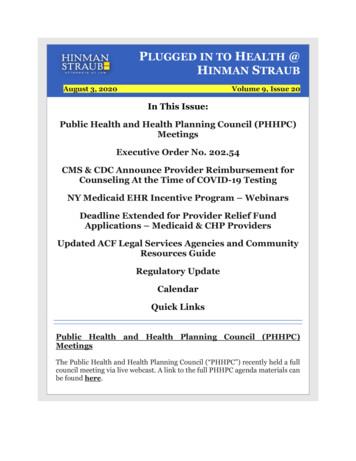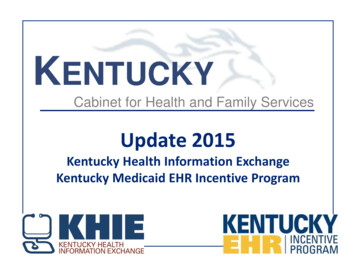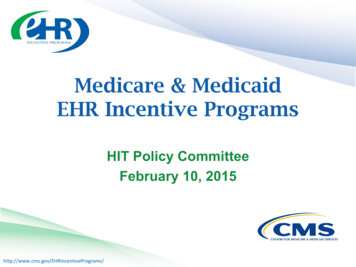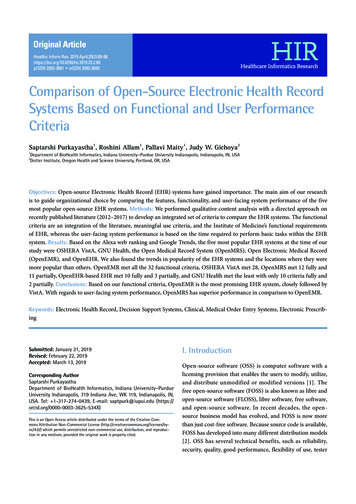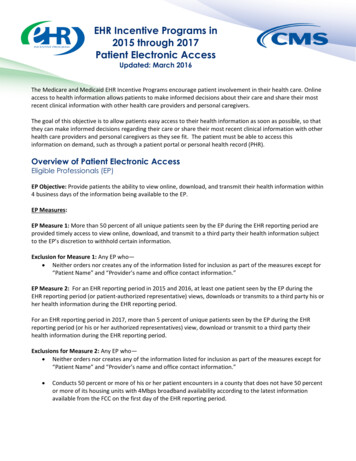
Transcription
EHR Incentive Programs in2015 through 2017Patient Electronic AccessUpdated: March 2016The Medicare and Medicaid EHR Incentive Programs encourage patient involvement in their health care. Onlineaccess to health information allows patients to make informed decisions about their care and share their mostrecent clinical information with other health care providers and personal caregivers.The goal of this objective is to allow patients easy access to their health information as soon as possible, so thatthey can make informed decisions regarding their care or share their most recent clinical information with otherhealth care providers and personal caregivers as they see fit. The patient must be able to access thisinformation on demand, such as through a patient portal or personal health record (PHR).Overview of Patient Electronic AccessEligible Professionals (EP)EP Objective: Provide patients the ability to view online, download, and transmit their health information within4 business days of the information being available to the EP.EP Measures:EP Measure 1: More than 50 percent of all unique patients seen by the EP during the EHR reporting period areprovided timely access to view online, download, and transmit to a third party their health information subjectto the EP’s discretion to withhold certain information.Exclusion for Measure 1: Any EP who— Neither orders nor creates any of the information listed for inclusion as part of the measures except for“Patient Name” and “Provider’s name and office contact information.”EP Measure 2: For an EHR reporting period in 2015 and 2016, at least one patient seen by the EP during theEHR reporting period (or patient-authorized representative) views, downloads or transmits to a third party his orher health information during the EHR reporting period.For an EHR reporting period in 2017, more than 5 percent of unique patients seen by the EP during the EHRreporting period (or his or her authorized representatives) view, download or transmit to a third party theirhealth information during the EHR reporting period.Exclusions for Measure 2: Any EP who— Neither orders nor creates any of the information listed for inclusion as part of the measures except for“Patient Name” and “Provider’s name and office contact information.” Conducts 50 percent or more of his or her patient encounters in a county that does not have 50 percentor more of its housing units with 4Mbps broadband availability according to the latest informationavailable from the FCC on the first day of the EHR reporting period.
Alternate Exclusion in 2015 for Measure 2: Providers may claim an exclusion for the second measure if for anEHR reporting period in 2015 they were scheduled to demonstrate Stage 1, which does not have an equivalentmeasure.Eligible Hospitals/Critical Access Hospitals (CAHs)Eligible Hospital/CAH Objective: Provide patients the ability to view online, download, and transmit theirhealth information within 36 hours of hospital discharge.Eligible Hospitals/CAH Measures:Eligible Hospital/CAH Measure 1: More than 50 percent of all unique patients who are discharged from theinpatient or emergency department (POS 21 or 23) of an eligible hospital or CAH are provided timely access toview online, download and transmit to a third party their health information.Eligible Hospital/CAH Measure 2: For an EHR reporting period in 2015 and 2016, at least 1 patient who isdischarged from the inpatient or emergency department (POS 21 or 23) of an eligible hospital or CAH (or patientauthorized representative) views, downloads or transmits to a third party his or her health information duringthe EHR reporting period.For an EHR reporting period in 2017, more than 5 percent of unique patients discharged from the inpatient oremergency department (POS 21 or 23) of an eligible hospital or CAH (or patient authorized representative) view,download or transmit to a third party their health information during the EHR reporting period.Exclusion for Measure 2: Any eligible hospital or CAH that is located in a county that does not have 50 percentor more of its housing units with 4Mbps broadband availability according to the latest information availablefrom the FCC on the first day of the EHR reporting period.Alternate Exclusion in 2015 for Measure 2: Providers may claim an exclusion for the second measure if for anEHR reporting period in 2015 they were scheduled to demonstrate Stage 1, which does not have an equivalentmeasure.MEASURE 1 - ACCESSThe specifications for measure 1 allow the provision of access to take many forms and do not require a providerto obtain an email address from the patient. Although many certified EHR technology (CEHRT) products may bedesigned in that fashion, it is not required by the program. If a provider’s CEHRT does require a patient emailaddress, but the patient does not have or refuses to provide an email address or elects to ‘‘opt out’’ ofparticipation, that is not prohibited by the EHR Incentive Program requirements nor does it allow the provider toexclude that patient from the denominator. The patient may also access their information through their patientauthorized representative.The measure timeline for making any health information available resets to 36 hours for an eligible hospital orCAH and 4 business days for an EP each time new information is available to which the patient should beprovided access. Therefore, although a provider does not need to enroll a unique patient a second time if the2
patient has a second office visit during the EHR reporting period, the provider must continue to update theinformation accessible to the patient each time new information is available.A patient who has multiple encounters during the EHR reporting period, or even in subsequent EHR reportingperiods in future years, needs to have access to the information related to their care for each encounter wherethey are seen by the EP or discharged from the eligible hospital or CAH’s inpatient or emergency department.If the provider fails to provide access to a patient upon an initial visit during the EHR reporting period, butprovides access on a subsequent visit, the patient cannot be counted in the numerator because the patient didnot have timely online access to health information related to the first visit. Similarly, the patient cannot beincluded in the numerator if access is provided on the first visit, but the provider fails to update the informationwithin the time period required after the second visit.The measure does not address the enrollment process or how the initiation process to ‘‘turn on’’ access for apatient within an EHR system should function. The measure addresses the health information itself.NUMERATOR CLARIFICATIONTo count in the numerator, this health information needs to be made available to each patient for view,download, and transmit within 4 business days of its availability to the provider for each and every time thatinformation is generated whether the patient has been ‘‘enrolled’’ for three months or for three years.DENOMINATOR CLARIFICATIONThe patient needs to be seen by the EP during the EHR reporting period or be discharged from the hospitalinpatient or emergency department during the EHR reporting period in order to be included in the denominator.MEASURE 2 – VIEW, DOWNLOAD, TRANSMITThe calculation may include actions taken before, during, or after the EHR reporting period if the period is lessthan one full year; however, consistent with FAQ #8231, these actions must be taken no earlier than the start ofthe same year as the EHR reporting period and no later than the date of attestation.NUMERATORSome CEHRT may not calculate the numerator in this fashion and therefore we will allow providers to use analternate calculation for an EHR reporting period in 2015 and 2016 if that calculation is a part of their CEHRT toallow sufficient time to upgrade the calculation prior to providers attesting to data for an EHR reporting periodin 2017.3
QUESTIONS AND ANSWERSQ: What does “necessary information” include?A: Necessary information could include website address, username and password, and, if needed, instructionson how to create a username and log on to the website.Q: Where can I find the certification requirements for the patient electronic access measure?A: The certification criteria for the patient electronic access measure are outlined in the 2014 certificationcriteria table on the HealthIT.gov website. Information can also be found in the patient electronic accessspecification sheets for eligible professionals and eligible hospitals/CAHs.Q: What health information must eligible professionals and eligible hospitals make available topatients?A: All information available at the time the information is sent to the patient website must be made available tothe patient online. However, the provider may withhold any information from online disclosure if he or shebelieves that providing such information may result in significant harm.Q: If multiple eligible professionals or eligible hospitals contribute information to a shared portalor to a patient's online personal health record (PHR), how is it counted for meaningful use whenthe patient accesses the information on the portal or PHR?A: If multiple eligible professionals or eligible hospitals contribute information to an online portal or PHR duringthe same EHR reporting period, all of the providers can count the patient to meet the measure if the patientaccesses any of the information in the portal or PHR. In other words, a patient does not need to access thespecific information an eligible professional or eligible hospital contributed, in order for each of the eligibleprofessionals and hospitals to count the patient to meet their threshold. See FAQ #12821.Q: Are eligible professionals and eligible hospitals required to provide growth charts to meetthe patient electronic access objective?A: CMS encourages all eligible professionals and eligible hospitals who have the certification capability togenerate and make growth charts available to patients. However, because this certification capability is notrequired, eligible professionals and hospitals do not need to generate and make growth charts available in orderto meet the objective.Q: In calculating the meaningful use objectives requiring patient action, if a patient accesseshis/her health information made available by their eligible professional, can the other eligibleprofessionals in the practice get credit for the patient’s action in meeting the objectives?A: Yes. If a patient views, downloads or transmits to a third party the health information that was madeavailable online by their EP, that patient can be counted in the numerator of the 2nd Patient Electronic Access4
measure for any of the EPs in that group practice who use the same CEHRT and saw that patient during theirEHR reporting period. See FAQ #12825.Q: Can an eligible professional or eligible hospital charge patients a fee to have access totheir health information?A: CMS does not believe it would be appropriate for the eligible professional or hospital to charge the patient afee to access certified EHR technology. See FAQ #9112.5
address, but the patient does not have or refuses to provide an email address or elects to ''opt out'' of participation, that is not prohibited by the EHR Incentive Program requirements nor does it allow the provider to exclude that patient from the denominator. The patient may also access their information through their patient
